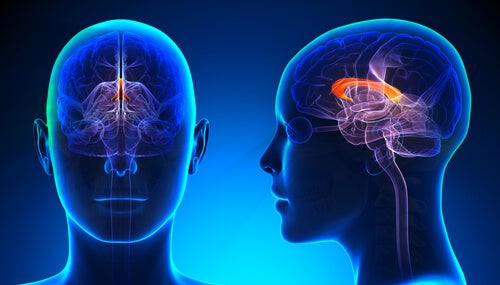The Left-Handed Brain: Difference and Advantages

Have you considered the difficulties left-handed people have in a world that seems to be designed for right-handed people? Although certain tools and objects do take left-handed people into account, not everyone has access to them. This means that people who have a left-handed dominance, a left-handed brain, need to adapt.
Today, we want to look at the particularities a left-handed brain has, apart from its adaptation needs. We’ll also try to understand how left-handed people configure their brain’s activities and how this can change. All of this taking into account a wide range of factors and variables: from its anatomy to its performance in people’s daily activities.

Laterality in the left-handed brain
We can say that a left-handed person is one who has left body dominance or preference. Therefore, they prioritize the use of their left foot, eye, hand, and ear to perform activities. The name experts give to this is cerebral laterality.
Laterality develops from psychomotor skills. It includes concepts such as the development of the body schema, muscular development to carry out activities, and the necessary balance to perform them. Therefore, in a left-handed person’s body, the process of psychomotricity is different from that of right-handed people. Left-handed people strengthen, and give preference to, the left side of their body.
In terms of cerebral laterality, the process is different. To explain this point, it’s important to clarify the hemispheric preference that we find in most brains. In the left hemisphere, there’s more control over language functions and sequential information processing. The right hemisphere, on the other hand, mostly deals with spatial and body information activities.
Therefore, brain laterality in left-handed brains usually has the same organization but the functionality is usually different. In other words, the way the left side of the body was stimulated means that the distribution of the body schema, muscle development, and balance are stimulated differently. The brain prioritizes areas of the right hemisphere, without forgetting the left hemisphere.
In this sense, it’s important to point out that the complete definition of the laterality of the brain coincides with a stage of acquisition of multiple skills – skills that are needed for school. This fact may have an impact on the development of these skills.
School skills in left-handed people
Laterality is the preferential use of one hand for school activities, such as writing. With this learning process, the brain creates sensitivity circuits and motor control circuits in areas involved in writing.
In the left-handed brain, although these circuits are adequately developed, this process can run into difficulties. This is due to the fact that, because of the way they write, they can’t see what they’re doing very clearly. Because of this, they’re prone to making more mistakes in the learning process. It also creates problems such as getting ink on your hand when you’re writing.
In addition to this, experts have also noted some reading difficulties. This is due to the brain’s innate tendency in left-handed people to want to read from right to left, as opposed to left to right, which most languages require people to read in. This creates difficulties in the organization of predictive reading, and can create a potential delay in the acquisition of this skill.
Another difficulty in the school environment is the tiredness left-handed people can experience when performing pencil and paper activities or manual activities such as cutting.
They tend to be slower developing these activities, since they have to be more careful when calculating the direction of their hand movements. Also, they have to be more careful not to smudge their work when moving their hands.
Does the left-handed brain have an advantage in creativity?
Among the characteristics attributed to the left hemisphere, we can find:
- Spatial and visual skills
- Creativity
- The ability to synthesize
- Artistic talent
Experts believe, therefore, that the “left-handed brain” is more sensitive, creative, and imaginative. This is due to the stimulation of this hemisphere during its development, which could give greater emphasis to this characteristic.
Because of this, left-handed people’s brains make it easier for them to develop tasks that require greater creativity. Art is a prime example of this, and some of the most renowned artists of all time, such as Leonardo Da Vinci, Raphael, or Michelangelo, were all left-handed.
Even so, it’s important to clarify that the fact you may be right-handed doesn’t mean that you can’t develop this ability. It simply means that the left-handed brain, due to this constant stimulation, may have advantages when it comes to developing this area.
Psychological characteristics in the left-handed brain
Functional imaging research has found that the size of the corpus callosum in the left-handed brain is larger. The explanation they give for this is that, in order to properly integrate information, and correctly develop activities, your brain must generate more interhemispheric connections.
Also, experts have found that, in the left-handed brain, the sense of directionality and rotation is different. In activities where you need to rotate something, you do it clockwise.
In addition to this, the way it processes graphic information is from right to left. This will give a person advantages when it comes to abstracting three-dimensional objects more easily and developing visuospatial skills more precisely.
Another characteristic that has been found in people with a predominance in the right hemisphere of their brain has to do with how they acquire knowledge about their surroundings. They tend to focus on what they see as a whole, and then, later on, on the smaller details. This makes it easier for them to be more coherent, and to find more unconventional solutions to everyday problems.

Flexibility and adaptation
In many cases, people with left-handed brains are under pressure from childhood to adapt to a world that’s made for right-handed people. As a side effect, this pressure often makes left-handed people more psychometrically adept. It can also improve interhemispheric connections, facilitating the learning of new information.
This ability to adapt also increases flexibility, especially cognitive flexibility. This makes them more competent when it comes to performing tasks that relate to multitasking skills and being innovative. They can be very adept at finding adaptive solutions to changing demands.
Conclusion
In conclusion, it’s important to understand that left-handed people live in a world designed, and intended for, right-handed people. Because of this, they’re the ones who very often have to adapt. This causes the left-handed brain to train itself and create strategies that can give it a cognitive advantage in certain situations.
Although there are some difficulties in the acquisition of learning regarding reading and writing, with these strategies, they usually manage to find a way around it and learn at the same pace as right-handed people. Similarly, the advantages in creativity that they have, due to the stimulation of the right hemisphere, makes it easier for their brains to create alternative solutions to problems.
All cited sources were thoroughly reviewed by our team to ensure their quality, reliability, currency, and validity. The bibliography of this article was considered reliable and of academic or scientific accuracy.
- Andrade-Valbuena, L. P. (2016). Diferencias en flexibilidad cognitiva entre zurdos y diestros manuales. Recuperado de https://reunir.unir.net/handle/123456789/4573
- Pérez, J. A. P. (2009). Cerebro Derecho, Cerebro Izquierdo. Implicaciones Neuropsicológicas de las Asimetrías Hemisféricas en el Contexto Escolar. Psicología educativa, 15(1), 5-12.
- Taco, C. L. A. (2014). Lateralidad zurda, un problema y una solución. Alétheia, 2(1), 29-38. https://doi.org/10.33539/aletheia.2014.n2.1089
This text is provided for informational purposes only and does not replace consultation with a professional. If in doubt, consult your specialist.








